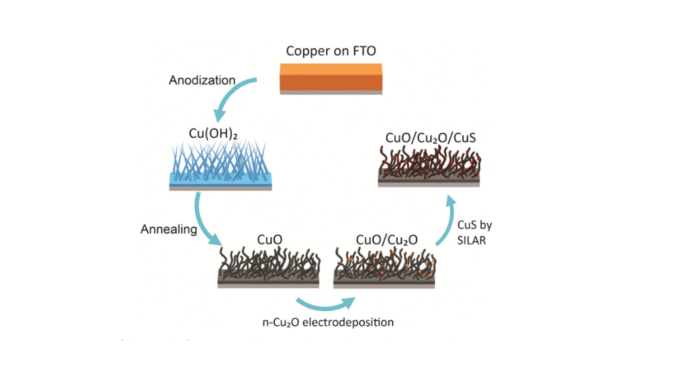


The researchers used copper nanostructures such as p-type cupric oxide (p-CuO) combined with n-type cuprous oxide (n-Cu2O) and copper monosulfide (CuS) as photocathodes for the reaction to split water into oxygen and hydrogen (image: CDMF)
Published on 01/30/2025
Agência FAPESP * – Research by the Center for the Development of Functional Materials (CDMF) has described how to obtain multilayer films that could eventually be applied as photoelectrocatalysts to obtain hydrogen at a low cost. This gas is a future option as a clean fuel for vehicles and generators.
The CDMF is a FAPESP Research, Innovation and Dissemination Center (RIDC) based at the Federal University of São Carlos (UFSCar).
Multilayer films are made up of countless plastic products used in many different segments. They are widely used in food packaging due to their important properties such as mechanical resistance, oxygen barrier, gloss and transparency, combined with ease of processing and a compatible cost.
The CDMF researchers used copper nanostructures such as p-type cupric oxide (p-CuO) combined with n-type cuprous oxide (n-Cu2O) and copper monosulfide (CuS) as photocathodes for the reaction to split water into oxygen and hydrogen.
The fabrication involved the deposition of copper on substrates by electroplating, followed by anodizing to generate copper (II) hydroxide nanowires, which were converted into copper (I) oxide nanowires using the annealing technique. Next, Cu2O and CuS particles were deposited by electrodeposition, a technique that consists of immersing the material to be coated in an electrolytic solution containing anions, and by the ionic layer adsorption and successive reaction method.
The photocurrent in the CuO/Cu2O/CuS-type films was high and, combined with the ease of fabrication of these materials and the low cost of the process, indicates that this is a promising material for use in hydrogen production processes using solar energy.
The study was published in the article “Enhanced photoelectrochemical water splitting using nanostructured films: p-CuO sensitized with polyhedral n-Cu2O particles and CuS as photocathode” in the scientific journal Materials Advances.
* With information from the CDMF Press Office.
Source: https://agencia.fapesp.br/53818